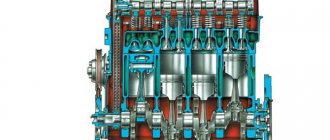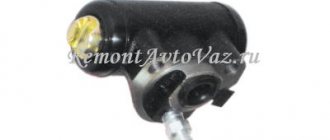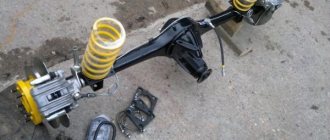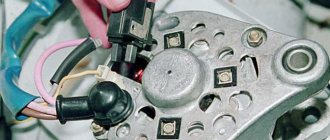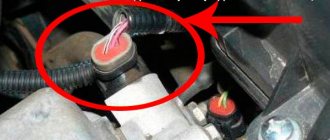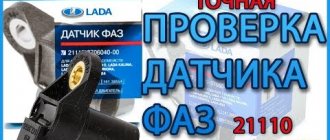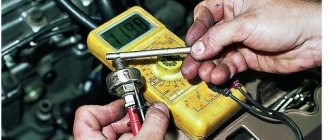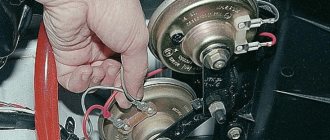The rear axle of the classic Zhiguli is an integral part of the car, without which it would be impossible to move it. The unit consists of several mechanisms to which torque from the engine and gearbox is transmitted through a cardan transmission. As the owner of a VAZ 2106, you need to know about possible problems with the rear axle and be able to fix them on your own.
- Technical characteristics of the rear axle
Table: characteristics of the rear axle of the “six”
- Frame
- Excessive noise from rear wheels
Video: identifying the cause of noise in the rear axle
- Replacing the axle shaft seal
Video: replacing the roller bearing of a Zhiguli axle shaft
- Table: parameters of rear axle oil seals VAZ 2106
- Checking the condition of elements
- Checking the oil level and adding oil
Rear axle VAZ 2106 - purpose
In the design of a car, the rear axle (RA) plays an important role. Through this unit, the drive wheels are connected to each other, and they are also attached to the body and torque is transmitted to them. The unit consists of several individual elements, which may wear out over time and require repair or replacement. Therefore, the design of the rear axle of the VAZ 2106, its malfunctions and repairs should be considered in more detail.
The rear axle is located at the rear of the car and is designed to attach wheels, rear suspension and transmit torque to the wheels
Dependence of acceleration parameters on mass
Engineers and designers know that there are a couple of classic methods to help improve vehicle data. And weight, or rather its ratio, plays almost the most important role in this matter.
Purely hypothetically: if you reduce the weight of the “six” by 10 percent, then the acceleration time to hundred (as we remember, it was 16 seconds) will also decrease by 10 percent. And this is already 15 seconds, which, you agree, is a good result.
To be specific, such a linear relationship between weight and acceleration only works in airless space, that is, in space. In fact, the car does not increase its parameters after 130 km/h, since it is impossible not to take into account the ASV (aerodynamic impact). And no matter how you reduce the weight of the car, you won’t help the matter. She will devote a lot to overcoming resistance. For example, if the power is 80 hp, then 40 hp. will definitely go to resistance, and the other half to acceleration.
It turns out that on cars with more power, weight reduction will have a more positive effect. The power unit still has a lot of power left for acceleration.
Another interesting point concerns the following. During maximum acceleration, the rear axle of the “six” is loaded. A portion of the weight moves from the front to the rear. For a rear-wheel drive car, this is only for the better - road traction becomes more effective. For the same reason, if we are talking about reducing weight on the “six”, it is recommended not to touch the rear, but to localize efforts to unload the middle and front zones.
Note. Another advantage in this regard can be considered the transfer of some components from the hood to the luggage compartment. For example, it could be a battery, washer reservoir, etc.
A few tips to ease the “six”
In order to make the VAZ 2106 a little lighter, it is recommended to do the following:
- Operate the vehicle with an incomplete fuel tank. As you know, a tank filled to the brim means an extra 80 kg of weight, which will certainly affect acceleration and fuel consumption.
- Some experienced drivers also keep the washer reservoir empty - an extra 4-15 kg of weight.
- Carrying a spare tire with you is, of course, correct. But without a spare wheel, the car loses about 12-25 kg, and this is no longer trivial.
- A lot also depends on the type of disk. Thus, it is recommended to use forged wheels. They reduce not only the total, but also the inertial mass by 10-20 kg.
- It is advisable to install the lightest battery. So, a 70-amp battery weighs 5 kg more than a 55-amp battery. We draw the appropriate conclusions.
More tips regarding more bodywork:
- Welding the frame will not only increase the rigidity characteristics of the body, but also significantly reduce the weight. The fact is that in this case an unnecessary, extra piece of metal is cut out of the body (no longer needed to maintain rigidity). In addition, it will be possible to install lightweight doors;
- You can replace standard heavy glasses with polycarbonate ones. This will reduce the weight of the car by 30-50 kg;
- You can install bumpers made of lightweight materials instead of standard ones. It will also be necessary to remove standard fasteners and clamps, which will ultimately result in a weight reduction of 20-70 kg;
- The hood and trunk can be replaced with similar ones, but made of composite materials;
- The audio systems in the car, including speakers and a huge subwoofer, also affect the mass;
- You can replace the seats with sports ones;
- Muffler tuning, carried out correctly, results in a weight reduction of up to 40 kg;
- Lightening the power unit by replacing cast iron manifolds;
- Installing a light flywheel results in a reduction of 3-8 kg;
- Standard suspension elements can be replaced with tuning ones, aluminum levers can be installed;
- Replace the steering wheel and gear shift knob.
Remember that the weight of the VAZ 2106 body affects not only the acceleration of the car, but also its other important parameters. Reducing weight affects good handling, braking and much more.
The instructions for lightening the weight of a car given above are not the only one of its kind. Every driver acquires valuable knowledge over time and uses it. In general, competent tuning of a car can be done with your own hands, if you know the nuances and technical data of a particular car model. Videos and photos will greatly help in this matter.
Rear axle specifications
In terms of their design and characteristics, the drive axles of all classic Zhiguli cars are the same. The only difference is in the gear ratios of the main pairs.
Table: characteristics of the rear axle "six"
| Parameter | Index |
| Factory catalog number | 21062402010 |
| Length, mm | 1400 |
| Crankcase diameter, mm | 220 |
| Stocking diameter, mm | 100 |
| Weight without wheels and oil, kg | 52 |
| Type of transmission | Hypoid |
| Gear ratio value | 3,9 |
| Required volume of lubricant in the crankcase, cm3 | 1,3–1,5 |
Rear axle structure of VAZ 2106
The design of the “six” gearbox consists of such main components as a stocking, a gearbox and axle shafts. Each of them is an integral part, without which the normal functioning of the mechanism in question is impossible.
The rear axle consists of two main components: a beam and a gearbox
Frame
The housing or stocking of the rear axle consists of two stamped casings in the form of a pipe, which are connected to each other by welding. On the outside of the casings, flanges with machined seats for semi-axial bearings and cuffs are welded, which prevent lubricant from leaking out. The flanges have 4 holes for bolts that secure the brake shield, on which the brake cylinder with pads is mounted. Also, these bolts hold the oil deflector element and the plate, which secures the axle bearing in the stocking. In the middle part of the body there is a widening, which is the rear gear housing. The crankcase has holes for the breather, as well as for filling and draining lubricant. Brackets for attaching rear suspension elements are welded directly onto the stocking.
The rear beam consists of two interconnected hollow casings
Gearbox
The main function of the rear gearbox is to reduce and transmit torque from the cardan drive to the wheels of the rear axle. Structurally, the unit is made of a housing, main pair gears, and a differential box with roller bearings. The gear ratio of the unit depends on the number of teeth on the tip and planetary gear. On a VAZ 2106, the number of teeth of the driven gear is 43, and the driving gear is 11. The gear ratio is determined as follows: 43/11 = 3.9.
The gearbox design includes the main gear and differential
Half shafts
The main purpose of the axle shafts is to transmit the torque converted by the gearbox to the wheels of the vehicle. On one side, the axle shaft has splines, through which it engages with the gears in the gearbox, and on the other, there is a ball bearing that ensures rotation of the mechanism, and a flange for attaching the brake drum and rear wheel.
The axle shaft ensures fastening and rotation of the rear wheel
Body dimensions of the “six” and their verification
There is a concept of car body size. Along with this, it is customary to talk about geometric dimensions, which imply control standards and distances, the geometry of door and window openings, the distance between axes and much more.
As a rule, a car that has been in an accident is checked for displacement of the main body elements
Particular attention is paid to the following body parts:
- Diagonals. The car is driven onto the overpass, and then the distance from one extreme point of the floor to the other is checked diagonally using a tape measure. If there is a discrepancy between the distances on one side and the other, there is movement of the body;
- Racks. They are subject to mandatory verification. First of all, if the car has been in an accident, the whole side, not damaged, is diagnosed, and only then the damaged side.
Note. As for the choice of body points, in this case you can choose any. For example, you can select from the pillar to the extreme point of the rear door.
- Roof. To make sure that the roof is not leaking, you need to measure the dimensions of the doorways diagonally. The dimensions, of course, must match on both sides;
- Glass. The conformity of the windshield and rear windows is checked. Both are measured diagonally.
How bridge malfunctions manifest themselves
The rear axle of the VAZ “six” is endowed with its own characteristic problems, which manifest themselves in one way or another.
Excessive noise from rear wheels
There may not be many reasons for the appearance of large noise from the wheels of the rear axle:
- The wheel has become loose. In this case, it is necessary to check and tighten the fasteners;
- semi-axial bearing failure. The axle bearing wears out over time, resulting in a characteristic noise. The axle shaft needs to be inspected and the faulty element replaced.
Constant noise from the rear axle while driving
Sounds unusual for the normal operation of the device in most cases indicate problems. The main causes of malfunctions include:
- stocking deformation. If the case is deformed, you can try to restore it, but it is better to replace it with a serviceable one;
- bent axle shafts and excessive runout. In this case, the part must be replaced;
- increased wear on splines. It is necessary to inspect the gears and splines of the axle shafts, and then replace the damaged elements;
- the gearbox is incorrectly adjusted, gears or bearings are worn or broken. Complete disassembly, defect detection and repair of the mechanism is required;
If the bearing rollers are damaged, extraneous noise may appear in the operation of the rear axle. - low oil level. You need to check the level, bring it to normal and make sure that there are no leaks through the lip seals and gaskets.
Noise when accelerating the car
The appearance of noise when accelerating a vehicle may be associated with the following reasons:
- Worn or incorrectly adjusted differential bearings. The gearbox needs to be dismantled, inspected and repaired;
- The gearing between the teeth of the bevel and planetary gears is incorrectly set. The problem is solved by proper adjustment;
- wear of semi-axial bearings. It is necessary to remove the faulty axle shaft and replace the bearing;
- little lubrication. The problem is resolved in the same way as with constant noise.
Lack of lubrication in the gearbox leads to increased production and jamming of the mechanism
Noise when accelerating and braking the engine
If noise from the motor side is present when the motor accelerates and decelerates, then the reason is possible in the following:
- Excessive wear or damage to the shank bearings. Requires disassembly and diagnostics of the gearbox;
- Incorrect alignment of the teeth of the bevel and planetary gears. Eliminated by checking the integrity of the parts and setting the correct gap.
Video: identifying the cause of noise in the rear axle
Noises when cornering
Extraneous noise can appear not only when driving straight, but also when cornering. This may be due to the following reasons:
- Difficulty turning the satellites on the axis. Requires disassembly, inspection of serviceability and replacement of elements whose condition does not allow them to be used further;
- jamming of side gears. If the gears and the surfaces with which they come into contact have minor damage, then they are cleaned with sandpaper. Otherwise, failed elements must be replaced;
- Incorrect alignment of the differential gears. Diagnostics and correct adjustment of the gap are required;
- failure of semi-axial bearings. Defective elements must be replaced.
Knock when starting to move
If the “six” rear axle gearbox (RAZ) makes a knocking sound as soon as the car starts moving, then this may indicate the following:
- Excessive clearance between flange and tip. Inspection of the spline connection and replacement of worn parts is required;
- increased gap between the shank and the planetary gear. Eliminated by setting a gap;
- increased wear of the landing site under the satellite axis. If such a breakdown occurs, the box must be replaced;
- The rear suspension rod fasteners have dropped. The bolts need to be checked and, if necessary, tightened.
Oil leak
Lubricant may leak from the gearbox for the following reasons:
- wear of the bevel gear cuff. If a leak appears from the shank side, the oil seal must be replaced;
- Damage to the axle seal. If traces of grease appear on the brake flaps, this indicates wear of the axle shaft seal, which requires its replacement;
- The fastening of the gearbox to the stocking has become loose or the gasket has been damaged. In such a situation, it is necessary to tighten the fasteners or replace the seal.
When oil leaks, gear wear accelerates.
VAZ 2107 oil: important recommendations for its selection
Good day, dear blog readers who also happen to be happy owners of a vehicle.
Today we will pay attention to the owners of Zhiguli. There is only one question on the agenda: what kind of oil is needed for the VAZ 2107, as well as the frequency of its replacement
When might you need an oil change?
Let's start by looking at the power units in various modifications of this car. In the old days, the “seven” was equipped with a 1.5 liter carburetor engine. Since 2000, a car with a VAZ 21067 injection engine could be found on sale.
Zhiguli owners, like no one else, know perfectly well that for long-term engine operation it is necessary to change the oil regularly, and we will consider how much oil and how often to change it further. A pressure sensor will help us with this, which automatically analyzes the volume of oil inside all engine systems in various temperature ranges of its operation.
As soon as it becomes necessary to change the oil or top it up, the owner will be notified of this by a light indicator on the dashboard. This may happen for the following reasons:
- dilution of the lubricant mixture
- squeezing it out through connecting hoses, pipes, etc.
- loss due to loose clamps
- engine head gasket wear and much more
In addition to the fact that you need to monitor the oil level, you need to understand that it loses its characteristics during operation. The standard recommendation is to replace the lubricant every 10 thousand kilometers traveled. In cases where the car is not used regularly, replacement must be done every 6 thousand km.
Which lubricant to choose
The circle of experienced Seven car owners has collected a lot of practical data on the topic of when to change the engine oil and what it should be like:
- mineral. It was the only solution for decades, but fewer and fewer Zhiguli owners are currently using it. If frost sets in above minus 20, starting the car becomes very problematic. That is, you have to forcibly dilute the lubricant by heating in order to be able to turn the crankshaft with the starter
- synthetic and semi-synthetic. The best choice for this machine. By all criteria, such products are better than mineral ones. It provides better lubrication of rubbing parts and components, allowing you to extend the service life of the motor. Even at a temperature of -30 degrees or more, there will be no problems with starting. Despite the frost, the starter can start the engine even on the first try if there is a well-charged battery.
To understand how many liters you will need to purchase in the store, you should know the volume of the entire engine lubrication system. According to the instructions, the exact capacity is 3.75 liters, so you will have to buy at least 4 liters. The traditional capacity of most types of motor oils is 5 liters in one canister (if purchased not on tap). It is better to use the remainder for periodic topping up.
The lower the temperature of the engine oil, the thicker it is and the more difficult it will be to start the engine. It is these indicators from SAE, the American Association of Automotive Engineers, that formed the basis for traditional labeling, for example, 10W-30, 5W-40, and so on. These numbers and letters indicate the viscosity and other performance properties of the lubricating fluid.
The letter W itself indicates that the oil can be used in the winter season. The first number in front of it indicates what temperature it can withstand. As for the second number, it is a display of high-temperature viscosity, that is, it shows how many degrees the oil will withstand in the summer heat without changing its qualities.
If you take the advice of AvtoVAZ, then you should make a choice in favor of such manufacturers as Esso, Shell, Lukoil, Norsey Extra, Novoil. In addition, it is useful to adhere to the following general recommendations:
- it is advisable to use the exact type and modification of lubricant that was poured earlier
- For old, worn-out carburetor-type engines, mineral lubricant is quite suitable, since it does not erode deposits that cover microcracks in the engine
- new engines, and especially the injector, require synthetic oil. It prevents overheating of the power unit and extends its service life.
THIS IS INTERESTING: Replacing silent blocks for Renault Scenic 1
Rear axle oil
On the VAZ 2106, friction of the internal elements of the rear axle is reduced by means of GL5 class gear oil with a viscosity of 85W-90. The volume of the substance is 1.3 liters. There are many similar oils today, but for Zhiguli cars you can use less expensive ones, for example, TAD-17.
It is recommended to change the lubricant in the rear axle every 50 thousand km. mileage
You can fill the rear axle of the VAZ 2106 with TAD-17 oil
Checking the oil level and adding oil
To check the lubricant level and top up, you will need a 17 wrench and a special syringe. The procedure consists of the following steps:
- We place the car on a level surface.
- We unscrew the oil filler plug and use our finger to check the oil level: it should be at the level of the lower edge of the filler hole.
You can check the oil level in the gearbox with your finger by unscrewing the filler hole. - If necessary, top up using a special syringe to the required volume, then wrap the cap and wipe away any stains with a rag.
To fill the oil, use a special syringe
If the oil needs to be changed, then simply pour it into a suitable container, allowing it to drain well, and then fill in new oil in the required volume.
The rear axle of the VAZ “six” is a fairly reliable unit and does not require much attention. The need for repairs, if at all, occurs infrequently. The most common problems are leaking axle or shank seals. Replacing them is simple and does not raise any questions. A more complex procedure is replacing the axle bearings or repairing the gearbox. However, these mechanisms can also be repaired in a garage by carefully reading and following the step-by-step instructions.
Vehicle weights
The actual weight of the car is 1045 kilograms. The main units of the “six” have the following weight:
- 140 kilograms - engine with equipment (starter, generator, carburetor, etc.);
- 26 kilograms - gearbox;
- 10 kilograms - square shaft;
- 52 kilograms - rear gearbox;
- 7 kilograms - radiator grille;
- 280 kilograms - car body.
It is noticeable that the body is the heaviest structural unit of the car. It weighs as much as two engines with all the components. The remaining mass of 530 kilograms is scattered between interior trim parts, wheels, fuel lines, brake lines and other things, the discrepancy in mass of which does not reach such large values.
An interesting fact is that according to all the norms and standards of the Soviet economy, the “six”, having an actual weight of 1045 kilograms, fell into the category of small class vehicles, but at the same time, thanks to the engine capacity of the VAZ 2106, it was a full member of group number three.
